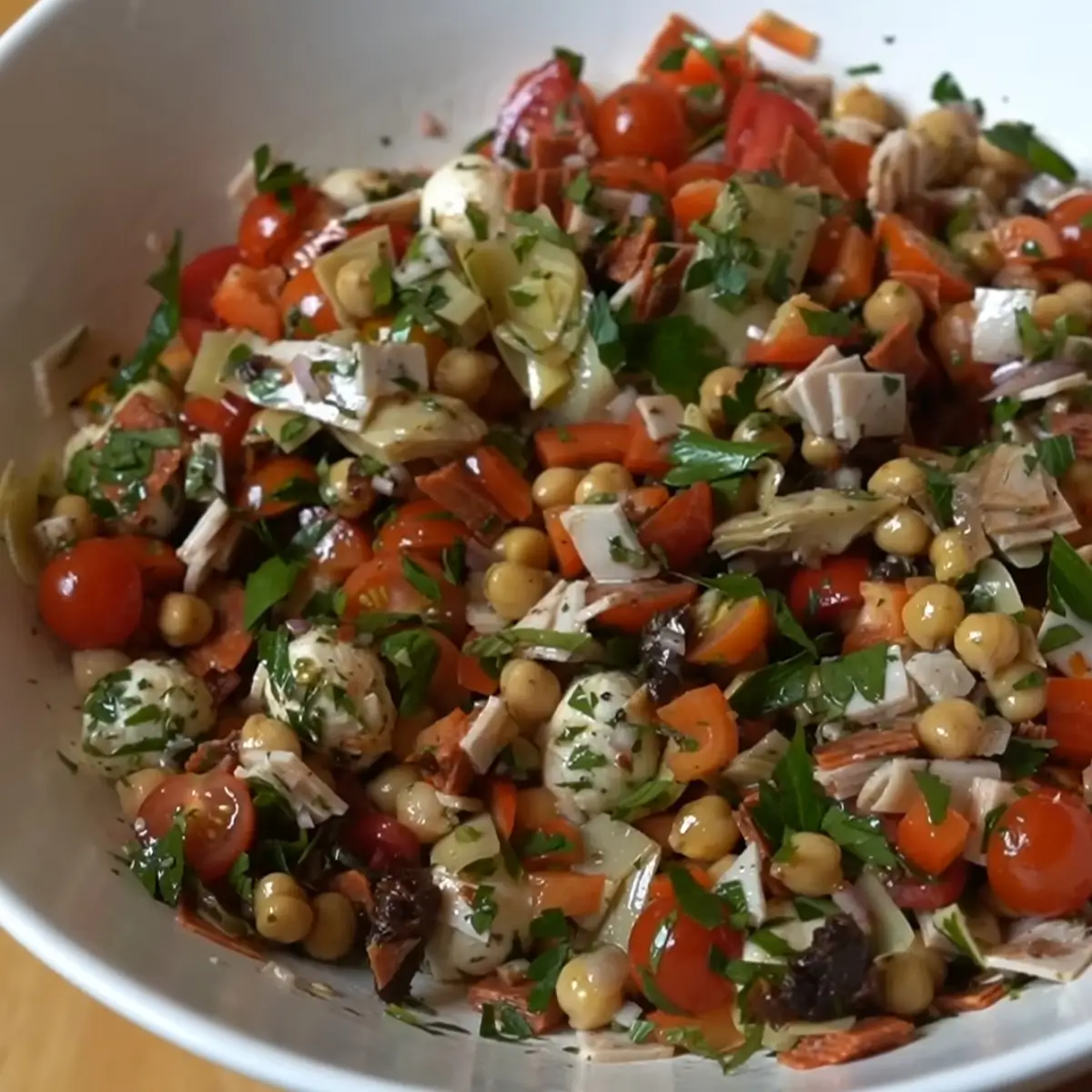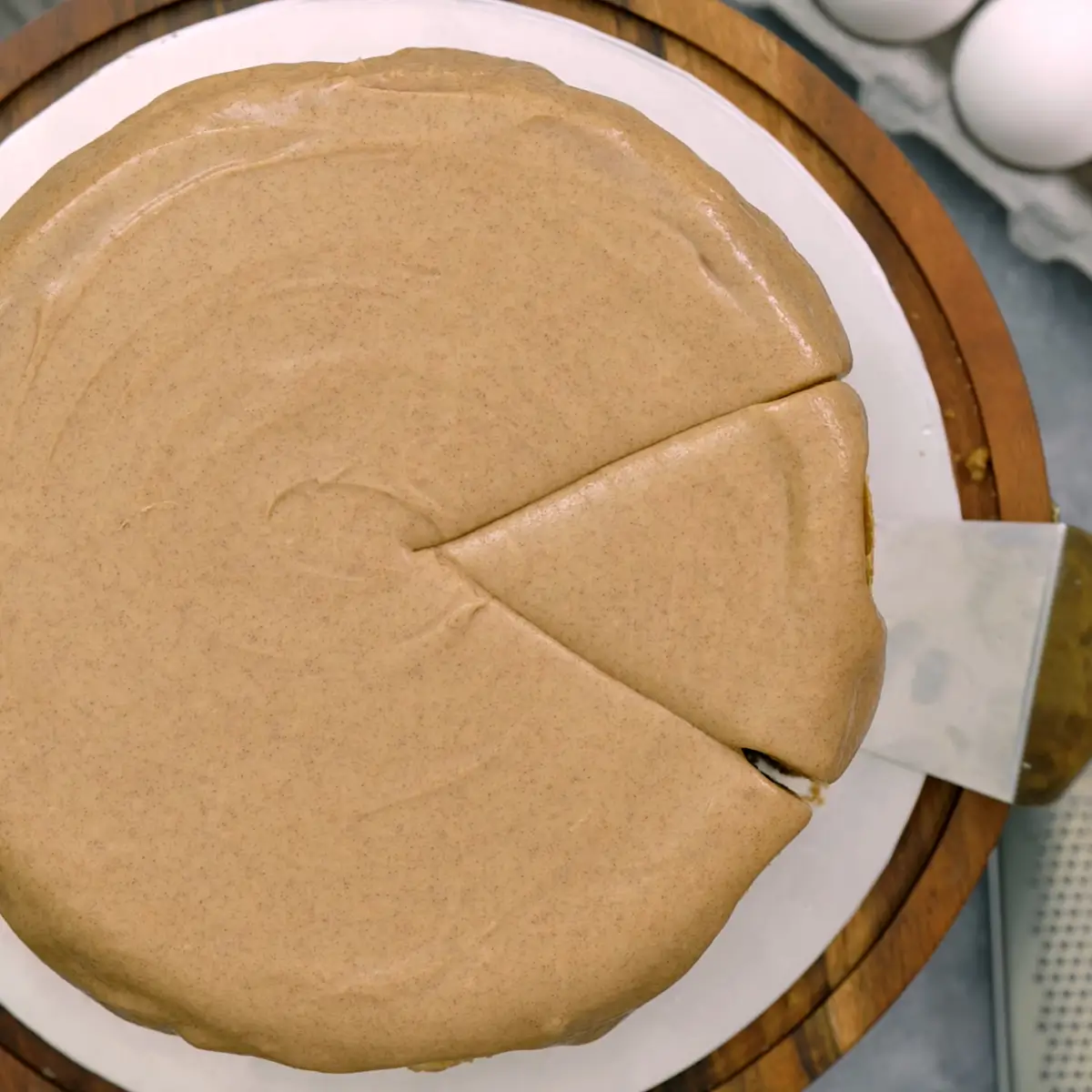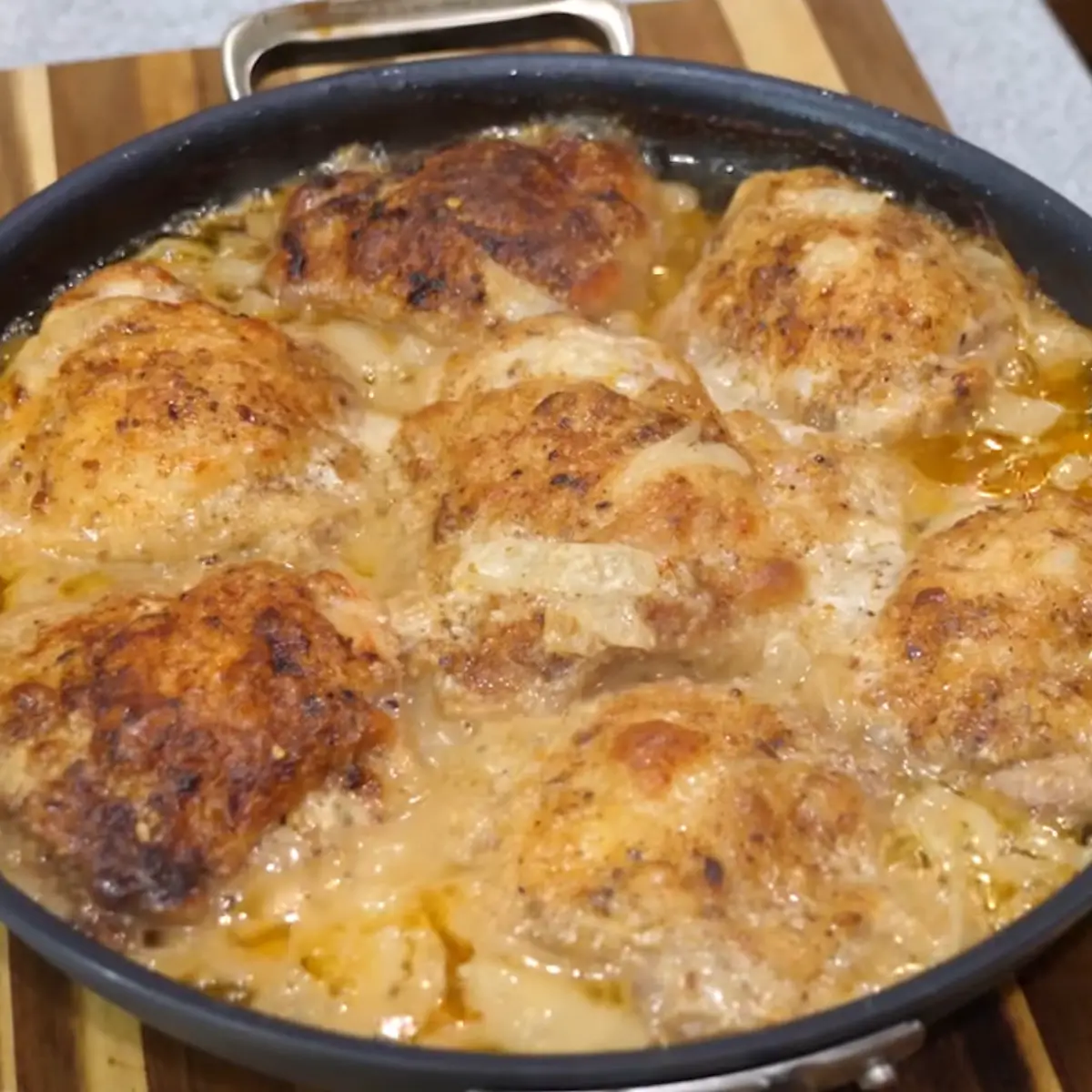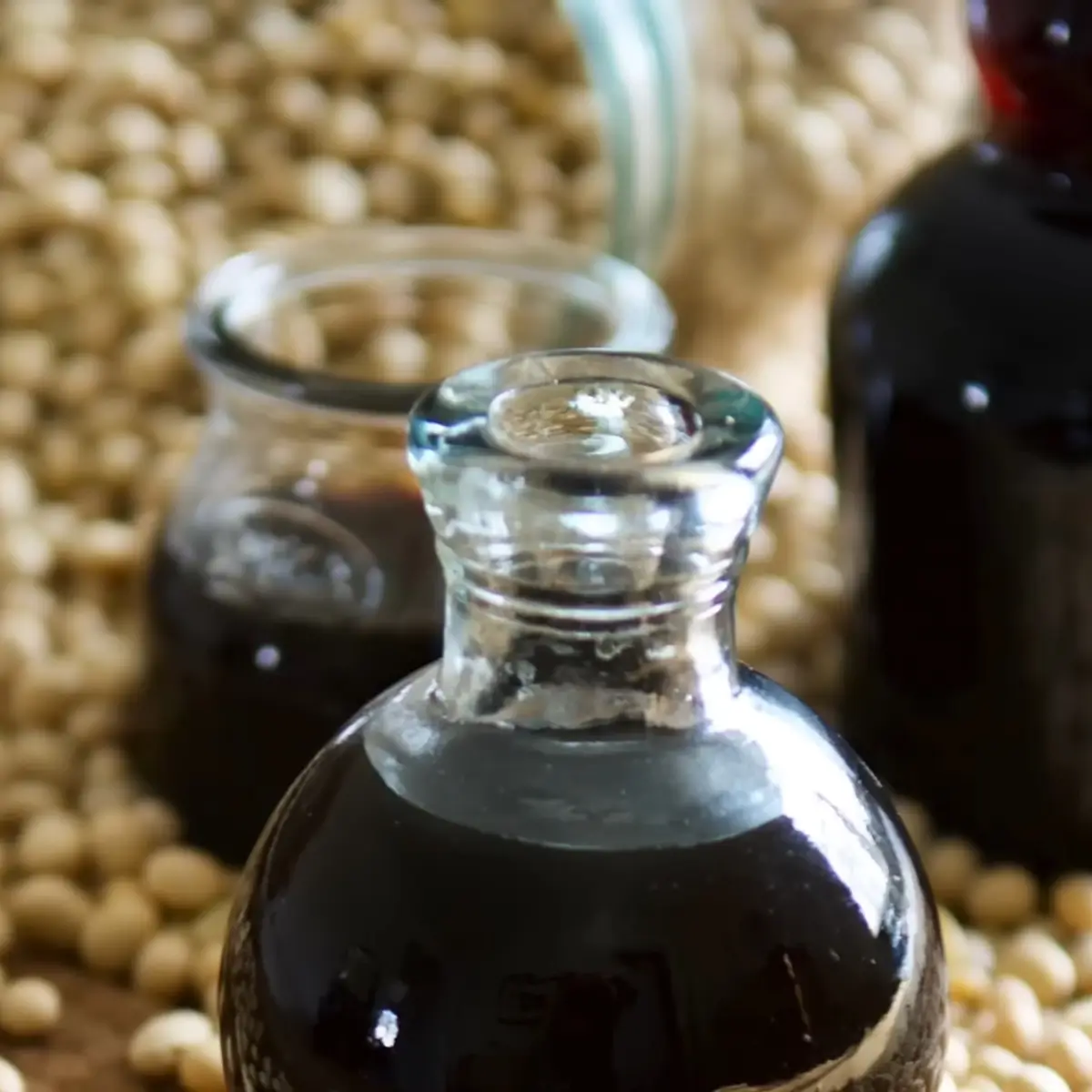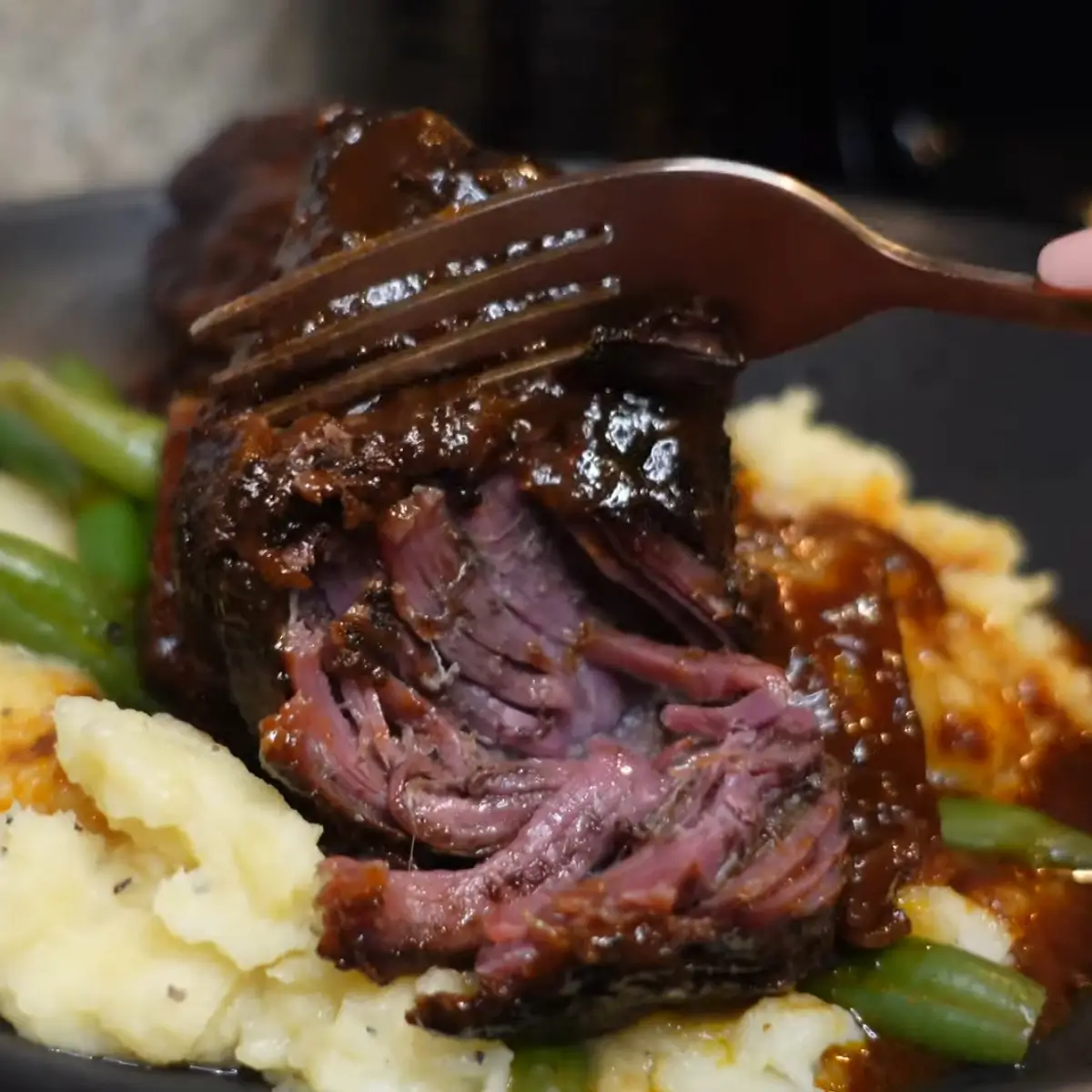When I was a child, I used to watch my Aunt Clara cook what she called her “Sunday magic” in the kitchen. Her favorite dish? Smothered chicken.
I remember the aroma of sizzling onions and the buttery golden gravy that wrapped the chicken like a warm blanket. She would always say, “We smother love into every bite.”
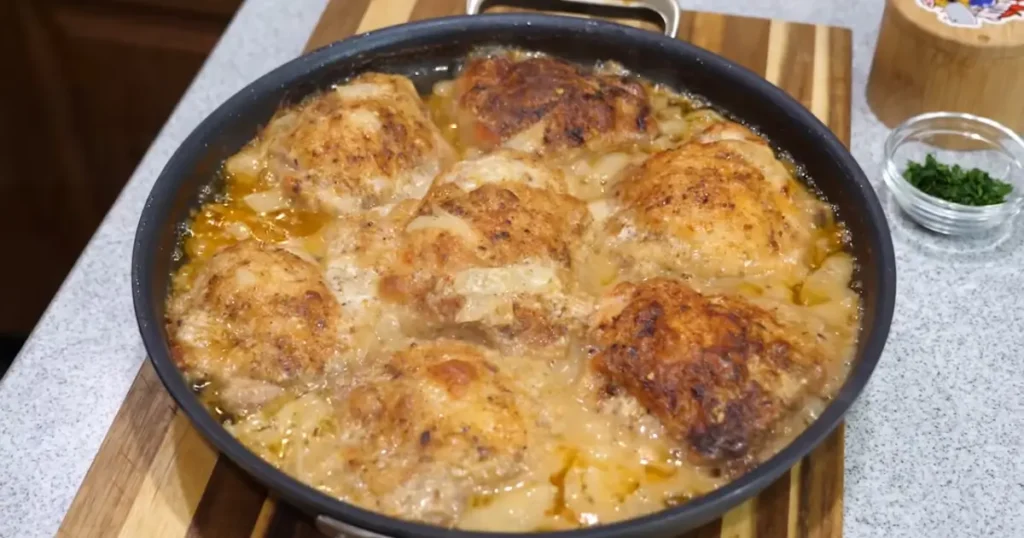
What Is Smothered Chicken?
Understanding the Smothering Technique
Smothering, in culinary terms, refers to a method of cooking where meat—often chicken—is first pan-fried and then slowly cooked in a covered pan with a flavorful gravy or sauce. Unlike simple pan-searing, this method traps steam and moisture, allowing flavors to deeply permeate the meat.
While it bears some resemblance to braising, the smothering technique is distinguished by its use of roux-based gravies and stove-top finishes. Braising often includes roasting in an oven, but smothering is an entirely stovetop affair, favoring low, slow heat to draw out complex flavors.
Origins and Cultural Significance
Smothered chicken is more than just a recipe, it is an heirloom passed down through generations. With roots in Southern, Creole, and Cajun cuisines, this dish embodies the historical tapestry of African, French, and Spanish influences found throughout the American South.
Originally a dish born of necessity, families used affordable cuts of meat and everyday ingredients like flour, onions, and oil. The magic came from technique. Over time, it became a staple in soul food recipes, celebrated for its richness and ability to bring people together around the table.
From Louisiana kitchens to Georgia porches, smothered chicken tells a story of resilience, resourcefulness, and deep culinary heritage.
Disclaimer: The information provided in this article is for educational and informational purposes only. It is not intended as a substitute for professional medical advice, diagnosis, or treatment.
Essential Ingredients for Authentic Smothered Chicken
Choosing the Right Chicken Cuts
Every time I make smothered chicken, I remember the first time I cooked it with my Mexican neighbor, Señora Lucia. She insisted that the quality and cut of chicken would make or break the dish. She was right.
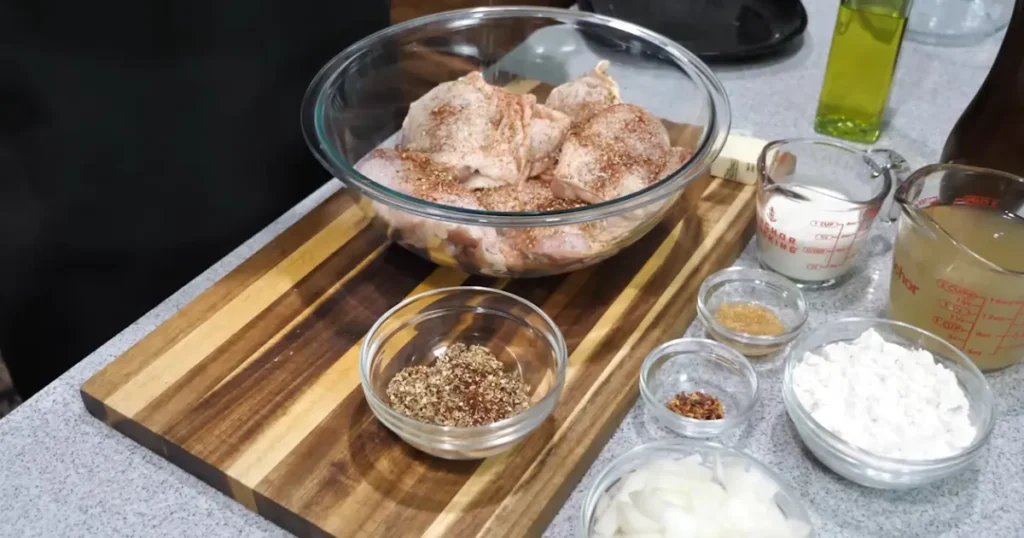
You can use either bone-in or boneless chicken for this dish. Bone-in chicken, especially thighs and drumsticks, tend to be more flavorful because the marrow infuses the gravy during cooking. Boneless breasts, on the other hand, offer quicker cooking and easier portioning.
Likewise, choosing between skin-on or skinless depends on your preference for texture and fat content. Skin-on chicken adds richness and helps maintain moisture, whereas skinless is leaner and better suited for dietary adjustments.
Key Components of the Gravy
The gravy is what makes this dish unforgettable. At its core is a well-crafted roux, a mixture of flour and fat cooked until golden brown. It acts as both a thickener and a flavor enhancer.
Here are the essential elements of the gravy:
- Butter or Bacon Drippings: Adds richness and depth.
- All-Purpose Flour: Forms the base of the roux.
- Onions and Garlic: Aromatic foundation that perfumes the entire dish.
- Herbs (like thyme and rosemary): Add complexity and freshness.
- Broth and Half-and-Half: Balance the roux with moisture and creaminess.
The resulting gravy is not only smooth and luscious but also packed with umami. These elements are essential to achieving that deep, comforting taste that defines Southern comfort food.
Cooking is chemistry and nostalgia all at once. When each ingredient is carefully chosen and layered with intention, the result is nothing short of art on a plate.
Step-by-Step Guide to Making Smothered Chicken
Preparing the Chicken
One autumn evening, as the rain tapped gently on the windows, I found myself recreating the dish my grandmother used to make when the weather turned cold. She believed there was no better way to warm the house—and the heart—than with a skillet of sizzling smothered chicken.
To begin, I took two large chicken breasts and sliced them in half lengthwise to create four thinner fillets. This technique allows for even cooking and a better sear. I then placed them between two sheets of parchment paper and gently pounded them with a meat mallet to an even thickness, about 3/4 inch.

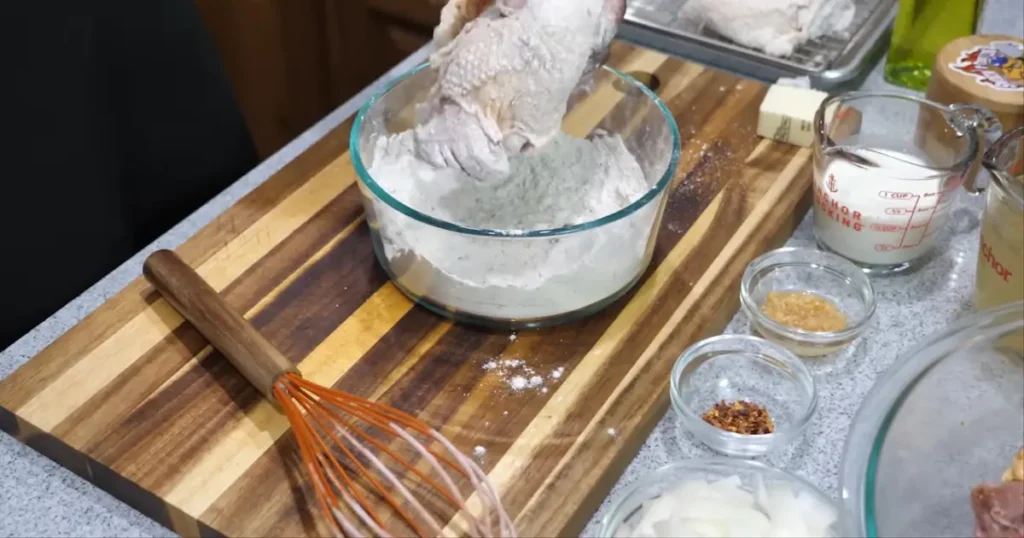
For the dredge, I combined all-purpose flour, seasoned salt, black pepper, and a hint of garlic powder in a wide, shallow dish. After patting the chicken dry, I coated each piece thoroughly in the flour mixture, ensuring it was evenly covered.
In a cast iron skillet, I heated a blend of vegetable oil and bacon drippings over medium-high heat. Once the oil shimmered, I carefully laid in the chicken, frying two pieces at a time for about 5 minutes per side until each piece turned golden brown with a crisp crust. I transferred them to a plate lined with paper towels and set them aside.
Crafting the Perfect Gravy
After removing the chicken, I poured out the oil, leaving behind the browned bits at the bottom of the skillet—these are culinary gold. I added butter to the pan and, once melted, whisked in an equal amount of flour to form the roux.


I let it cook until it reached a rich caramel hue, then gradually added chicken broth, whisking constantly to avoid lumps. Next, I poured in half-and-half for a velvety texture and incorporated chopped onions, garlic, thyme, and a dash of soy sauce for umami.

Combining Chicken and Gravy
Once the gravy thickened, I nestled the chicken fillets back into the pan, along with any juices that had collected on the plate. I reduced the heat to a simmer and partially covered the skillet, allowing everything to cook for another 10–15 minutes.

This final simmer melds the flavors, tenderizes the chicken, and transforms the dish into the kind of comforting meal that begs to be shared. A sprinkle of chopped parsley added freshness and visual appeal just before serving.
Variations and Regional Twists on Smothered Chicken
Southern and Soul Food Styles
When I visited Mississippi a few years ago, my cousin Monique introduced me to her version of smothered chicken that featured thick-cut bacon and a generous splash of heavy cream. She said it was “how Grandma used to do it,” and one bite was enough to convince me that some traditions are meant to be preserved.
In the Deep South, this dish often leans heavily into its soul food roots, with added richness and flavor enhancements. Bacon not only provides smoky depth but its drippings also become the base for the roux.
Some cooks even add bell peppers or celery for extra body. Heavy cream or evaporated milk elevates the gravy’s texture to an indulgent level that practically demands a side of fluffy biscuits or cornbread.
Classic sides include:
- Collard greens simmered with smoked turkey or ham hocks
- Black-eyed peas with a hint of vinegar
- Macaroni and cheese, baked to golden perfection
This version may be high in calories, but it is equally rich in tradition and comfort.
Health-Conscious and Dietary Adaptations
With more people seeking healthier lifestyles, I have experimented with modern takes on this beloved dish. Substituting almond flour for regular flour works well in gluten-free versions.
For those following Paleo or Whole30, using ghee instead of butter and coconut milk in place of dairy produces a surprisingly robust flavor.
Here are a few healthy alternatives:
- Skinless chicken breasts for lower fat content
- Olive oil instead of bacon grease or butter
- Low-sodium broth and no added salt options
Even with these modifications, the dish retains its identity. The secret lies in the method—slow cooking, thoughtful seasoning, and most of all, love.
Serving Suggestions and Pairings
When the smothered chicken is ready, piping hot and luxuriously coated in creamy gravy, the next question is: what do I serve with it? Growing up, my mother always said that no plate of smothered chicken was complete without something starchy to soak up that golden sauce.
Classic Side Dishes
Here are some timeless pairings that I return to again and again:
- Creamy mashed potatoes: Their buttery softness cradles the chicken and gravy perfectly.
- Steamed white rice: Absorbs the sauce like a dream, making each bite comforting.
- Buttermilk biscuits: Ideal for sopping up gravy to the last drop.
- Southern cornbread: Adds a slight sweetness and texture that pairs beautifully with savory chicken.
Vegetables are essential too:
- Green beans (steamed or roasted)
- Honey-glazed carrots
- Sauteed spinach or kale
These sides add color, nutrients, and balance to the meal.
Beverage Pairings
To complement the richness of the dish:
- Sweet iced tea: A Southern classic that cuts through the gravy’s depth.
- Lemonade: Offers a refreshing citrus brightness.
- Sparkling water with lime: Great for those seeking a non-sugary, cleansing contrast.
Ultimately, the best pairings are those that bring comfort and joy to your table. And that is what smothered chicken is all about.
Tips and Tricks for the Best Smothered Chicken
When it comes to smothered chicken, small adjustments can lead to significant improvements in taste, texture, and presentation. I have made this dish more times than I can count, and over the years, I have learned a few key lessons that never fail me.
Common Mistakes to Avoid
- Overcooking the chicken: Even with smothering, chicken can dry out if cooked too long. Always monitor the internal temperature and remove from heat when it reaches 165°F.
- Burning the roux: The roux is the soul of your gravy. Cooking it too fast or on high heat can result in a bitter flavor. Keep the heat medium to low and stir constantly.
- Using too much salt early on: Since ingredients like broth, bacon, and bouillon already contain sodium, wait until the end to adjust seasoning.
Enhancing Flavor and Texture
- Use a cast iron skillet: It distributes heat evenly and retains it, giving the chicken a perfect golden crust.
- Let the dish rest: Allowing the chicken to rest in the gravy for a few minutes off heat helps it absorb flavor and remain juicy.
Cooking smothered chicken is as much about intuition as it is about instruction. Over time, you will develop a rhythm, a personal flair that makes the dish truly yours. And in that, you find not just nourishment, but artistry.
Part 7: Frequently Asked Questions (FAQs) (300 words)
When people hear about smothered chicken for the first time, they are often intrigued—not just by the dish’s rich aroma and creamy texture, but also by the traditions and terminology behind it. Here are answers to the most commonly asked questions that I have received over the years.
Why is it called smothered chicken?
The name “smothered” comes from the cooking technique. In this method, meat—typically chicken—is first pan-fried and then cooked slowly in a closed environment (like a skillet with a lid) with a gravy or sauce.
This process effectively “smothers” the meat, locking in moisture and infusing it with flavor. The sauce permeates the meat deeply, giving it that signature tender bite and savory profile. It is less about visual appeal and more about the comfort it provides, just like a warm embrace.
What is smothered at Texas Roadhouse?
At Texas Roadhouse, “smothered” generally refers to grilled meat topped with sautéed onions, mushrooms, and a rich brown gravy. It is not quite the traditional Southern smothered chicken, but it shares the spirit—adding moisture and extra flavor layers to the meat.
Their version is more of a topping, whereas traditional smothering involves cooking the meat within the sauce itself.
What’s the difference between stewed chicken and smothered chicken?
While both involve cooking chicken in liquid, stewing typically means the meat is fully submerged and simmered in a broth or sauce over a longer period.
Smothered chicken, on the other hand, starts with a sear and is only partially immersed in gravy. Smothering also tends to use a roux as the base, making the sauce thicker and more luxurious compared to a lighter stew.
How do you smother?
To smother chicken, follow these steps:
Sear seasoned chicken in a skillet until golden brown.
Remove chicken and prepare a roux in the same pan.
Add aromatics and liquid to create the gravy.
Return the chicken to the skillet, cover partially, and simmer until cooked through.
This cooking method enhances the flavor while keeping the meat juicy and tender.
Exploring Smothered Chicken in Popular Culture and Media
Smothered chicken has not only earned its place at countless family dinners, but it has also carved out a space in the broader culinary conversation—appearing in cookbooks, cooking shows, and digital communities across the world.
Representation in Cookbooks and Cooking Shows
Some of the most iconic cookbooks on Southern comfort food feature a version of smothered chicken, each putting a unique spin on the traditional recipe. Authors like Edna Lewis and Carla Hall have praised the dish for its cultural value and satisfying nature.
On television, programs such as “The Pioneer Woman” and “Southern at Heart” have featured variations, demonstrating its versatility and timeless appeal. Its consistent presence speaks to how deeply this dish resonates with home cooks and professional chefs alike.
Online Communities and Recipe Sharing
In online forums and recipe-sharing websites, smothered chicken enjoys robust popularity. Thousands of users share their personal techniques—some adding hot sauce for a fiery kick, others using coconut milk for a Caribbean twist.
On platforms like YouTube and TikTok, creators regularly showcase their family traditions, complete with anecdotes and plating tips. Do not forgot to follow me on Facebook, Pinterest, and Medium for daily delicious inspirations.
Social media has helped breathe new life into this classic, introducing it to younger generations and international audiences who now see it as both nostalgic and new. The conversation around smothered chicken continues to evolve, bridging cultures and connecting kitchens.
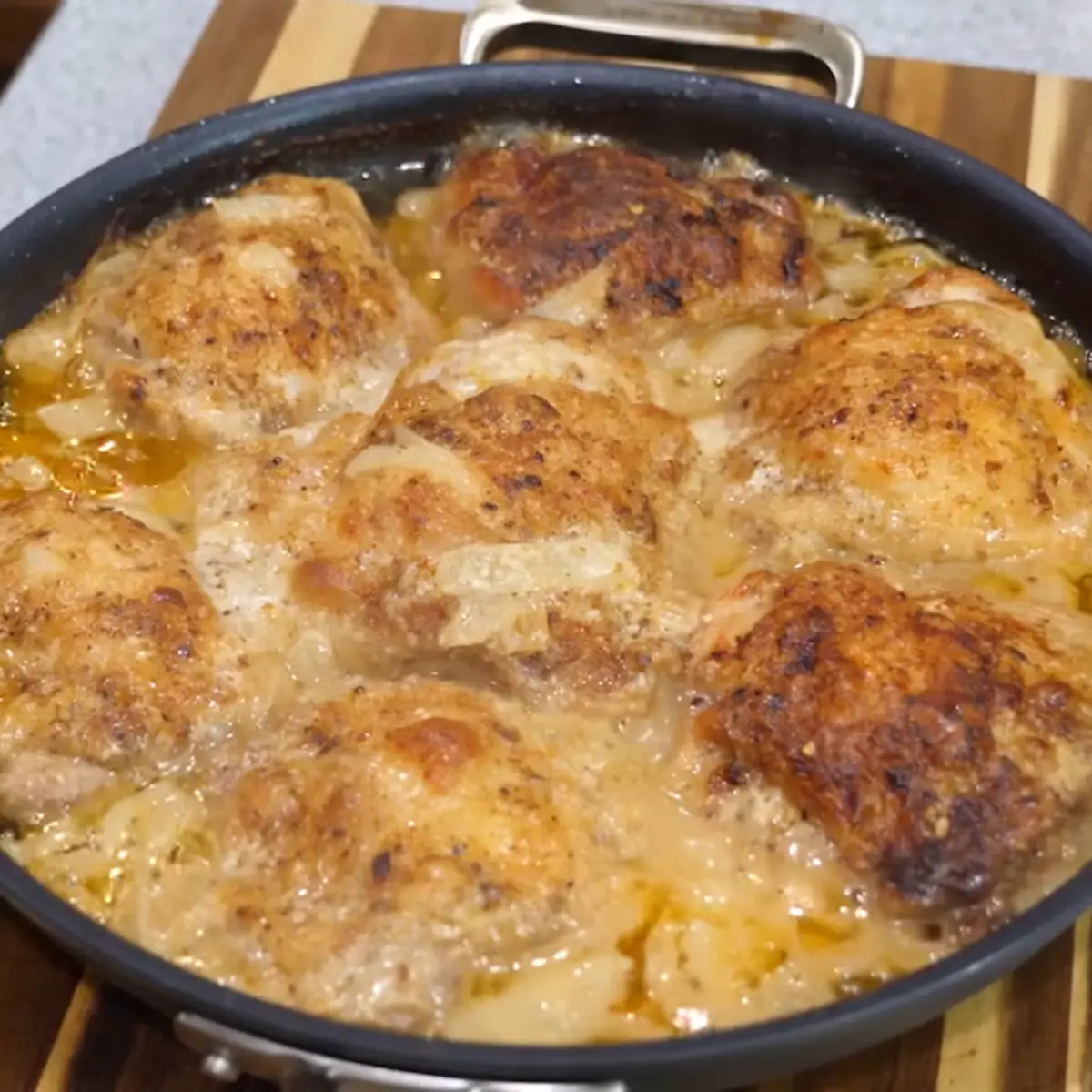
Smothered Chicken
Ingredients
Equipment
Method
- Cook bacon in a skillet until crisp. Reserve 2–4 tablespoons of clear drippings. Set bacon aside and discard any burned residue.
- Slice each chicken breast in half horizontally and pound to 3/4-inch thickness.
- Mix flour, breadcrumbs, seasoned salt, and pepper. Dredge chicken pieces and shake off excess.
- Add reserved drippings and enough oil to cover chicken halfway. Heat until shimmering. Fry chicken in batches, 4–5 minutes per side. Remove and set aside.
- Wipe out excess oil from the pan, but keep browned bits (fond) for flavor.
- Melt butter in pan and whisk in flour to form a roux.
- Slowly incorporate chicken broth and half and half while stirring to thicken.
- Stir in bouillon, soy sauce, and all seasoning. Add Kitchen Bouquet if using.
- Return chicken and juices to skillet. Chop bacon and sprinkle over top.
- Cover partially and simmer 10–15 minutes until chicken is 165°F.
- Garnish and serve hot with mashed potatoes or your favorite side.


